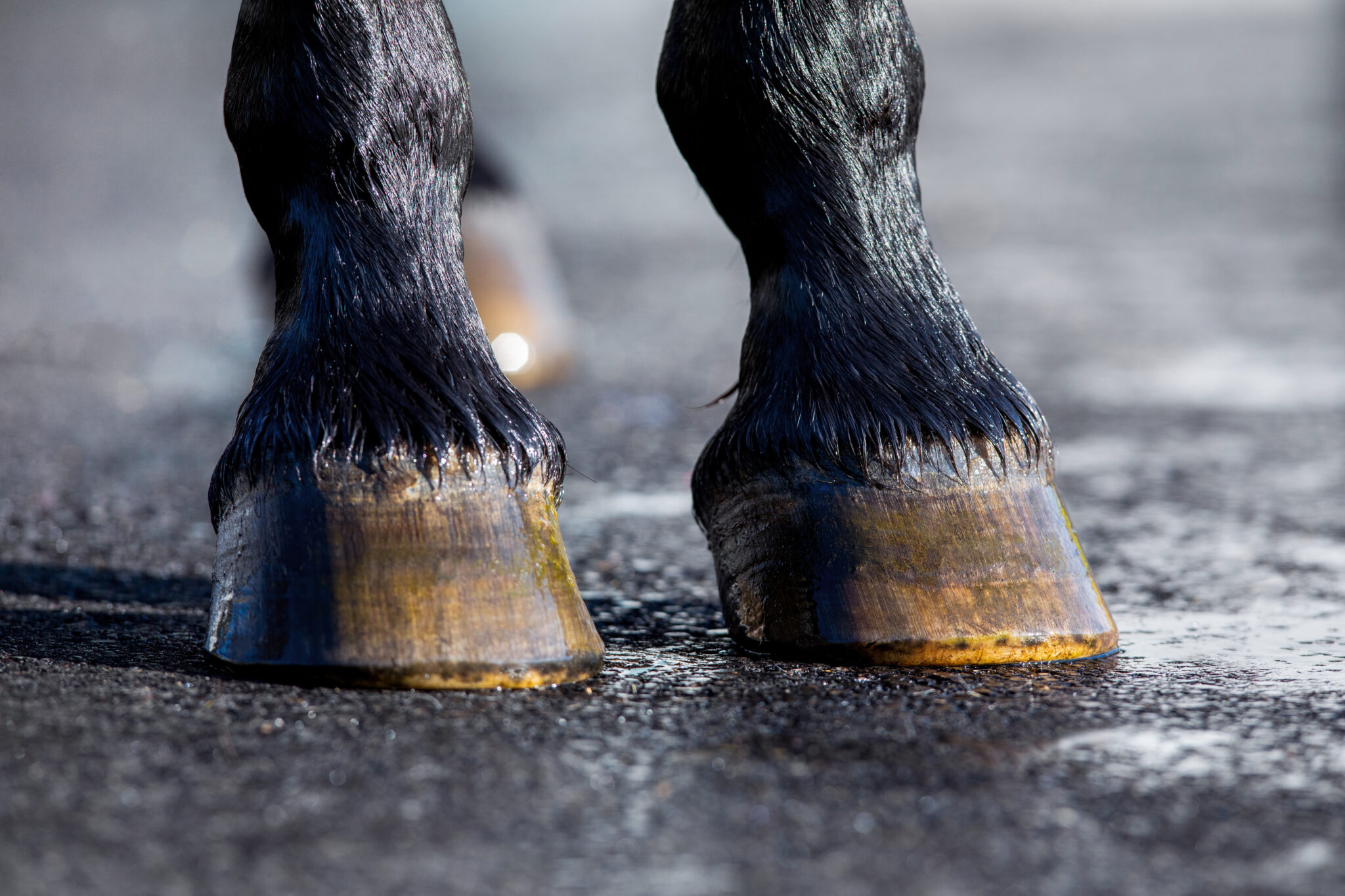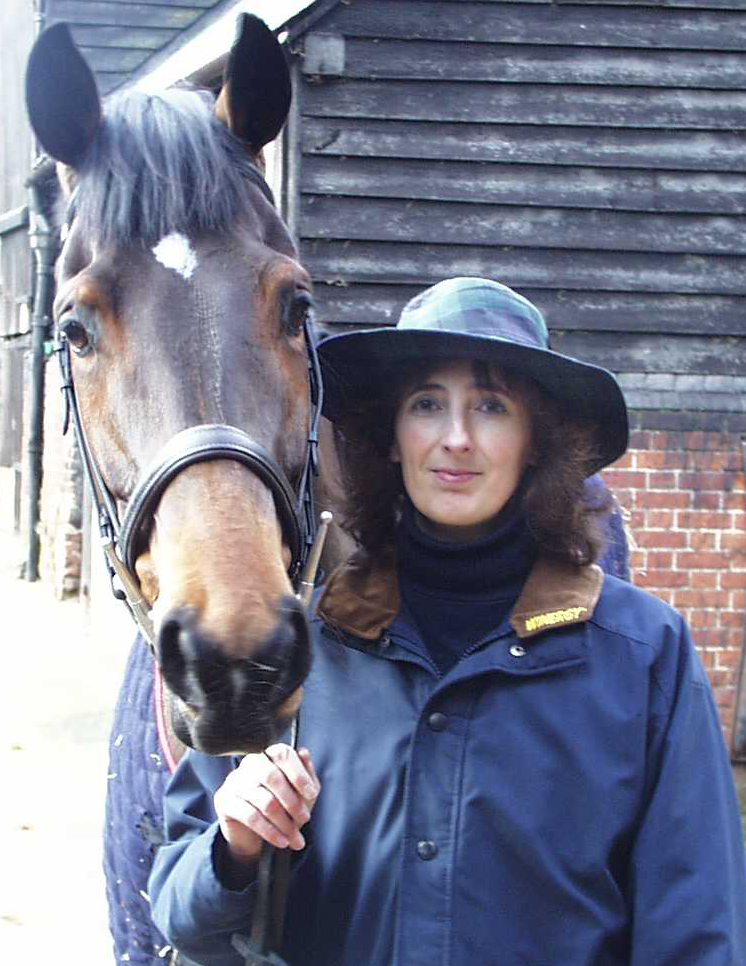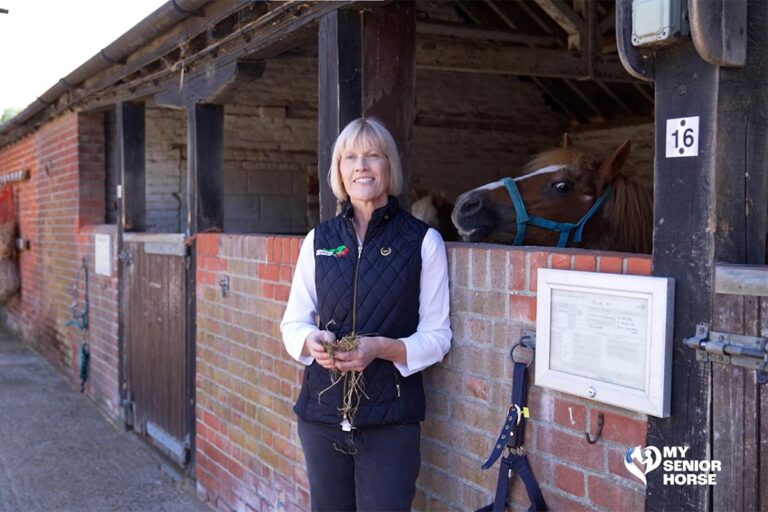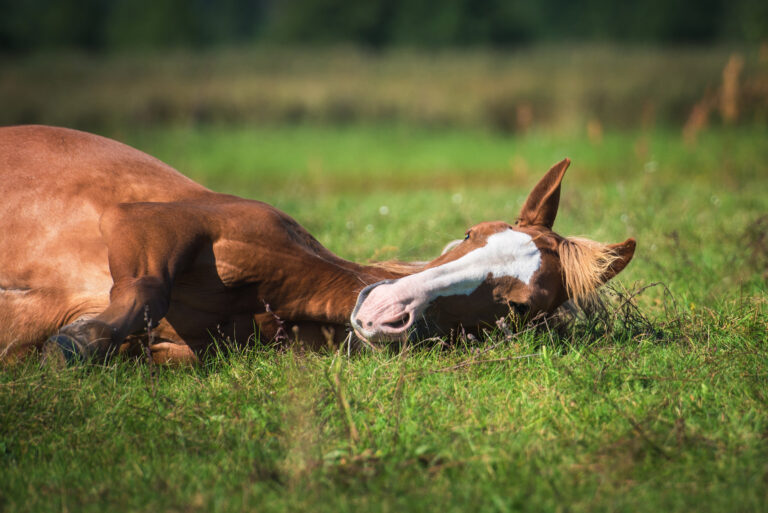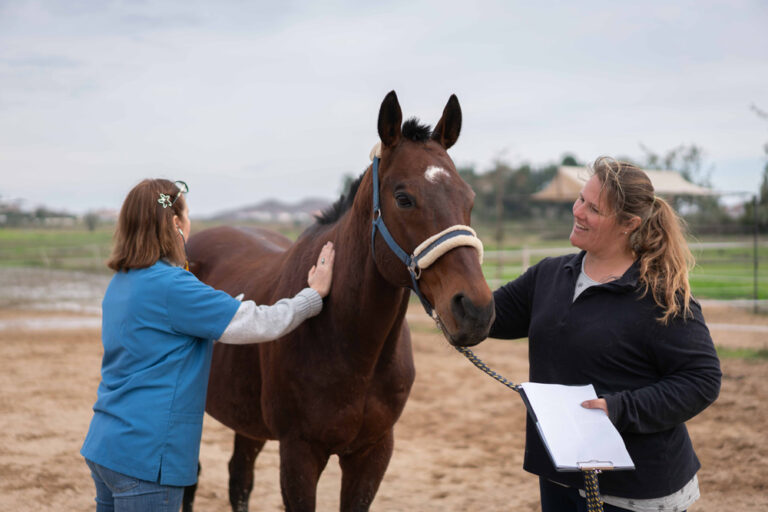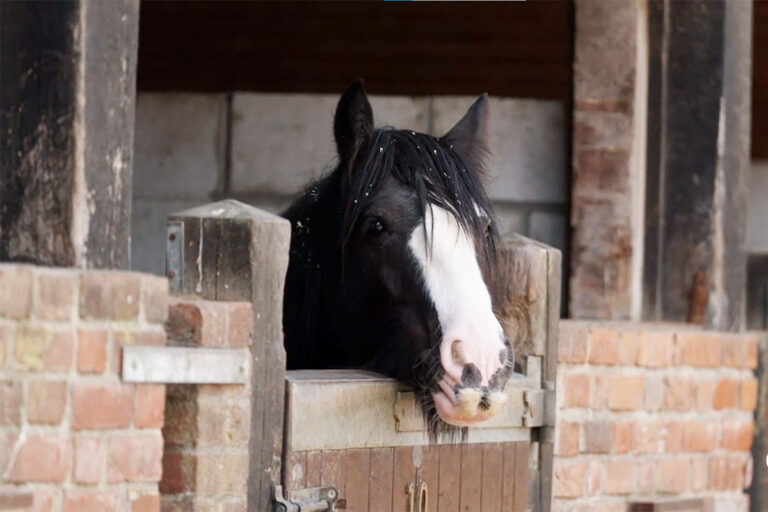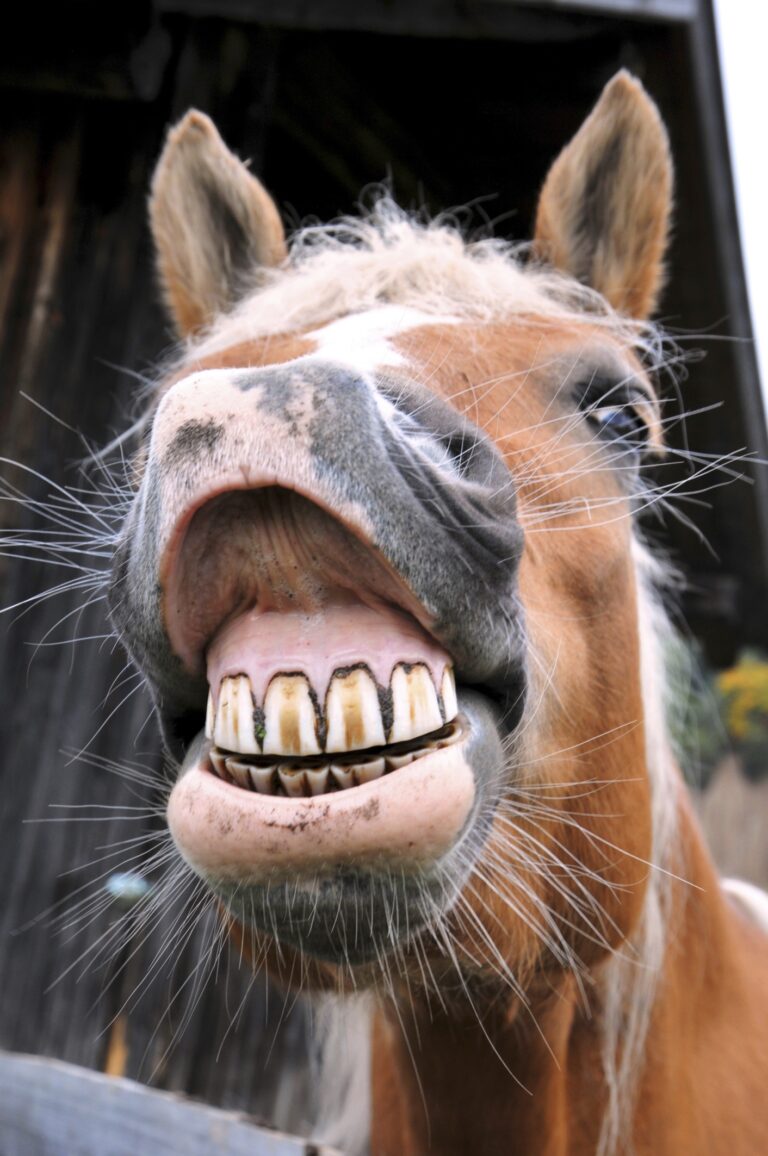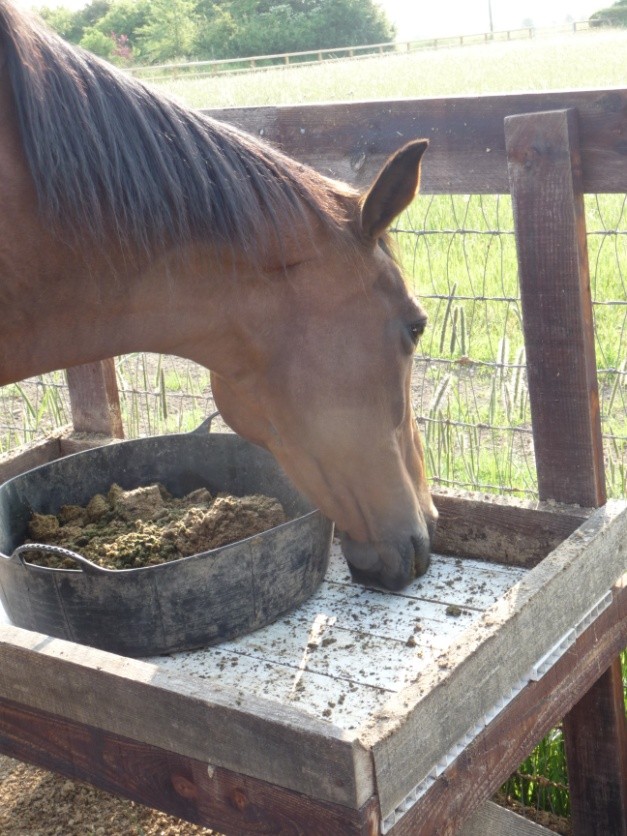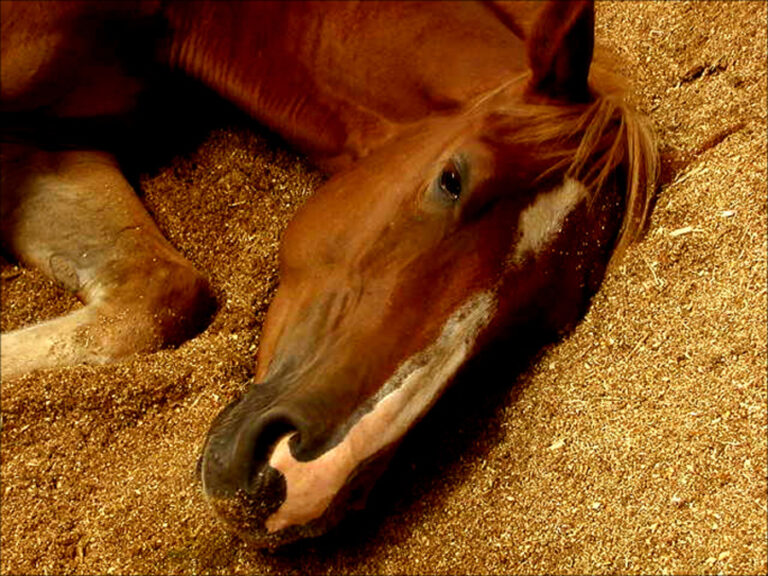Regardless of the bloodline or training, if the hoof wall is in poor condition, a horse may become a very costly pasture ornament! Poor hoof horn can show itself in many ways. These can include:
- chipped hooves
- cracks
- splits
- thin, flaky walls
- brittle feet
- soft horn that crumbles and falls away
- an inability to retain shoes for the ‘normal’ period between shoeings
- thin soles with chronic bruising or abscessation
- collapsed heels
These problems can often impair the horse’s ability to exercise when out in the field or while being ridden. This can result in a pottery gait (short-strided) on hard going and reluctance to stride out.
While many other problems may prevent a horse from being ridden, good hoof health is important for healthy day-to-day living.
What Affects Hoof Quality?
Many factors have been proposed as having the potential to affect hoof quality and appearance. We discuss these below.
- Stable and pasture management. Over-softening of hooves from too much moisture has been suggested to make the feet more vulnerable and prone to infections. Some horses spend considerable time with their hooves standing in either wet mud or feces/urine. Excessive mud and moisture have also been thought to strip the feet of natural oils so that when they do dry out they are more brittle. It has been suggested that poor-quality hoof horn is more sensitive to such factors than good quality hoof horn
- Footcare (including trimming/shoeing)
- Genetics/breed
- Physiological or biochemical abnormalities of the hoof itself. But in one study, no association was found between owner-reported hoof wall problems and hoof wall color despite a common belief that white hooves are more prone to poor-quality horn.
- Nutrition does play an important role in the cause and prevention of many hoof problems. It is very difficult to produce a strong, healthy hoof just by applying a topical dressing.
- Basic hoof health comes from a good diet.
What Is Hoof Wall?
The hoof is really a highly specialized skin. But, unlike skin, the hoof wall cells are organized into specific patterns. The wall thickness (linked to strength) is dependent on the cells remaining attached to each other.
The hardness of the hoof wall is in part due to specific proteins that coat the inside of individual cells and the lipids that lie between the cells cementing then together.
The complex process of hoof wall formation (cornification) is specific and highly organized. The growth rate of the hoof horn is different in various parts of the hoof and can vary with the time of year. The rate can differ between and within breeds and even between individuals that are housed under the same conditions.
Equine hoof growth rates have been reported in the literature as varying from around 0.19 to 0.48mm/day. However, for adult horses in the UK, it has been suggested that levels of around 0.2mm/day are typically expected. Keep in mind there will be seasonal variations.
Hoof Needs
It is not surprising, given the complexity of the growth process, that the nutritional requirements of the hoof are also quite complex.
Amino acids and lipids are obviously needed to allow the intracellular keratins and cell envelope proteins, as well as the extracellular matrix, to form.
Energy is needed to fuel the various processes. Vitamins and minerals are essential for the synthesis and function of the numerous enzymes and other factors needed for the regulation of the cornification process.
It is, therefore, also not surprising that there is not one single remedy for poor hoof quality.
Hoof Wall Requires a Good Diet
As mentioned above, many factors can affect hoof quality. Many of these factors might be out of the farrier’s and even the owner’s control (such as weather and genetics).
However, nutrition is one of the factors that we can influence!
In order to maintain the desired flexibility, elasticity, and strength that is essential to the foot’s architectural design, the proper nutrients need to be provided to the cells that make up the bone, dermis, and hoof wall.
Due to the pattern of hoof wall growth and metabolism, the primary impact of nutrition on the hoof wall is on the hoof cells as they are first formed. Proper nutrition is critical for the strength of the individual hoof wall cells. Therefore, if the supply of nutrients is inadequate, the hoof wall might be too fragile or will not have the proper flexibility to withstand the forces that are imposed on it.
Similarly, if the diet does not provide for the proper production of the extracellular lipid matrix that cements the hoof wall together, it will predispose to a wall that flakes, splits, or cracks easily.
Like other body tissues, the hoof requires provision of the basic nutrients to be able to grow. If the provision of such nutrients—in particular protein and energy—is limited, then growth will be affected.
What the Diet Needs
The first step in dealing with a horse with poor hooves (or in fact any horse) is to ensure that it is being provided with a nutritionally balanced diet. In particular, the diet needs to be adequate in essential amino acids. These include lysine and methionine. They are essential in that horses cannot make them from other amino acids in their diet.
Also critical to hoof health are vitamins and minerals such as calcium and phosphorus, plus the trace elements copper and zinc.
The exact amounts required will vary with the individual (according to its lifestyle and lifestage). Unfortunately, most pastures and forages do not provide such a diet unless they are appropriately supplemented.
Cereal grains are not adequately balanced for hoof support. In fact, they are imbalanced with respect to calcium and phosphorus, their amino acid content, and their vitamin and mineral levels.
When More Might Be Better: Biotin
An appropriate, adequate, and balanced diet will, in most cases, be enough to produce and sustain good-quality hoof horn and growth.
Making sure that your horse’s whole diet (taking into account all the feeds, forages, and supplements being fed) is balanced and adequate should be the first step whenever you have a horse with bad feet.
However, under certain circumstances, additional supplementation might be of value, including adding additional biotin.
Biotin is a water-soluble B vitamin (vitamins are organic substances which are essential for life, and are not degraded as sources of energy) that is particularly important in cell metabolism. It might also be required for cell proliferation and therefore for the healthy growth and maintenance of all body tissues.
Biotin has been identified as a key component of the metabolic pathways of cornification. A deficiency of biotin has often been related to poor skin, poor coat condition, and/or poor hoof quality in other species.
Although evidence of biotin deficiency per se has not been published in the horse, there is some scientific research to suggest that when supplemental biotin is added to the diet of horses with poor hoof health, an improvement might be seen in some but not all horses.
It is, therefore, important to recognize that biotin is not the cure-all/panacea for all horses with poor hooves. But, it might be worth considering for some horses.
Some types of hoof horn defects therefore will not respond to biotin alone. The problem might require other nutrients to be present in adequate or perhaps higher than normally recommended levels.
This is why hoof supplements typically include biotin together with other key nutrients such as calcium and zinc.
When More May Not Be Better: Selenium
Many key nutrients can cause clinical problems if they are not provided in sufficient quantities and in a balanced manner. In some cases, hoof wall quality might be adversely affected.
It is important, however, to guard against the belief that when X is good then 3 times X must be much better. This is definitely not the case for the hoof as is illustrated by selenium.
Selenium is a trace element, playing an important role in the antioxidant defenses of the body. An inadequate intake of selenium is associated in particular with certain conditions affecting the muscles.
This means it is important to maintain an adequate selenium intake, especially in young foals and exercising animals.
However, as with many nutrients, too much selenium can be toxic. For selenium in particular, the differences between adequate, optimum, and potentially toxic intake levels is fairly small.
What Is Selenium Toxicosis?
Selenium toxicosis can occur in any age, breed, or sex of equid. It is most commonly seen globally in horses on pasture.
The UK does not have the selenium-concentrating plants responsible for pasture-based toxicosis. Problems in the UK (and elsewhere) can occur from too much selenium being given either due to an error in manufacturing, high levels in the water, or excessive administration by injection. All of these problems are comparatively rare. The most common cause, however, is multiple supplementations or excessive supplementation by the owner or caregiver.
Acute selenium toxicosis (blind staggers) tends to result in blindness and signs relating to the gut, lungs, and heart. However, it is the more chronic form of toxicity (alkali disease) that causes problems for the feet.
Signs of More Chronic Selenium Toxicosis
Early lesions begin as lameness and soreness of the coronary band and feet. These are often accompanied by reddening and swelling of the coronary band. These signs are often missed as they settle down relatively quickly.
They are followed in one or more days by the development of a crack that occurs parallel to and just below the coronet (due to defective tubular horn produced by the dermal papillae of the coronary band).
Interestingly, it has been reported that the hind feet are often affected first.
Hoof separation and lameness progress for several months until the damaged hoof is displaced from beneath by new growth and sloughs off. Not surprisingly, affected animals are extremely lame.
The hair coat initially becomes very rough. Typically, hair loss occurs along the nape of the neck and on the tail. But in severe cases, a more generalized loss of hair might be seen.
Such marked cases of chronic toxicity are very rare. But less severe (albeit still significant) effects on hoof quality due to excessive selenium supplementation have been suggested. It has also been suggested that moderately high intakes of selenium, which are not toxic enough to cause the signs described above, may affect the frog horn and be a factor in some cases of persistent thrush.
Preventing Selenium Toxicity
Prevention is far more important than treatment when it comes to selenium toxicity. As mentioned above, a certain amount of selenium is good and essential for the health and wellbeing of horses.
Many regions in the UK, for example, are known to have low selenium pastures. Many forages and cereals are in fact deficient in selenium. So, not supplementing horses with selenium is likely to cause problems.
It is crucial to recognize the very narrow safety margin of selenium supplementation.
European legislation requires that horses should not be fed more than 0.5mg/kg of total diet based on feed with 12% moisture, which approximates to around 1mg/100kg BW (i.e., 5mg for a 500 kg horse). Keep in mind this is the legal definition of how much selenium can be in the total diet. It is not necessarily the level above which problems might be seen. The legal limit is based on a feed with 12% moisture (88% dry matter) rather than basing it on a total dry matter basis. This level would equate to most pellets and hays as they are fed, but it would not be simple to calculate if feeding haylage with a dry matter of 55%, for example. Make sure to talk to an equine nutritionist if you have any questions.
Nutritionally Supporting Good Hooves
Following are some recommendations to help support good hoof quality through nutrition.
- Feed a nutritionally balanced diet both in terms of an adequate amount of forage and an adequate, balanced supply of vitamins, minerals, and essential amino acids. In particular, ensure that the diet is well balanced for calcium, copper, zinc, and amino acids (especially lysine). Maintaining optimal ratios of calcium to phosphorus and copper to zinc can be advantageous.
- Treat each horse as an individual. Take into account workload, environment, breed, and type of horse when developing a suitable diet.
- Feed a balancer or broad-spectrum vitamin and mineral supplement if no or low levels of hard/bucket feed is being provided. Unlike broad-spectrum vitamin and mineral supplements, well-formulated balancers provide additional amino acids that might be of particular benefit for horses on restricted (or soaked) forage diets and/or if the quality of the forage is unknown. In the UK, levels of lysine in hay/haylage might be low, even though the crude protein or ‘total protein’ content is not.
- Do not over-supplement the diet with any nutrient, in particular selenium, calcium, methionine, or vitamin A. Take into account all sources of nutrients.
- Consider supplementing biotin or a hoof supplement containing suitable amounts of biotin, especially if the poor hoof quality persists despite the provision of an adequate and balanced diet throughout the year (remembering that dietary effects might take several months to show improvements).
- Avoid management practices that cause major disruption to the hind gut microflora. (Editor’s note: Check out ‘7 Management Tips to Reduce the Risk of Feed-Associated Equine Colic’ by Dr. Pat Harris.)
- If concerned, contact an equine nutrition advisor and/or your veterinarian.
Hoof Care and the Environment
Ensure that you employ good practices for hoof hygiene. That includes picking out the hooves at least once a day and regularly using a suitable disinfectant to give them a thorough clean, especially at critical times of the year. Contact your farrier for advice.
Try to ensure when stabled that the surface the horse has to stand on is clean and dry. Do not leave the horse standing unnecessarily on wet bedding for long periods of time.
Do not ignore soft, smelly feet. And, of course, maintain regular visits from your farrier.
Further Content
- Equine Nutrition Basics: Protein, Vitamins, and Minerals. Dr. Nettie Liburt. MySeniorHorse.com
A Guide to Feeding Mashes. Sarah Nelson. MySeniorHorse.com - Horse Feed Ingredients—Quality Not Just Quantity. Amber Krotky. MySeniorHorse.com
- Mycotoxins in Horse Feed. MySeniorHorse.com
- My Senior Horse Video: Overweight Horse Management. Bryan Cassill. MySeniorHorse.com
- A Guide to Equine Ration Balancers. Sarah Nelson. MySeniorHorse.com
- 7 Management Tips to Reduce the Risk of Feed-Associated Equine Colic. Dr. Pat Harris. MySeniorHorse.com
- Clinical Challenges for Senior Horses: Perspectives from an Equine Practitioner in Denmark. Dr. Nanna Luthersson. MySeniorHorse.com
- Tips on Feeding Older Horses with Dental Issues, Dr. Pat Harris. MySeniorHorse.com
- A Guide to Feeding Mashes, Sarah Nelson. MySeniorHorse.com
- Tips For Equine Weight Gain Through Increased Body Fat. Dr. Pat Harris. MySeniorHorse.com
Sign up for My Senior Horse’s FREE newsletter to get the latest information about equids 15 years and older delivered straight to your inbox!
-
Harris is a past president of the British Equine Veterinary Association and is a European specialist in veterinary and comparative nutrition. She is the Nutrition and Science Advisor to Mars Horsecare and the WALTHAM™ Equine Studies Group. Harris has spent much of the last 30 years working to help improve the care and nutrition of older horses. She also is passionate about seniors because of her dedication to her own older horses. She has advised on the care of many other seniors and has authored numerous articles on their care. Harris’ involvement in several global senior research teams gives her special insight into some of these studies. Harris is also on the Executive Advisory Council for My Senior Horse.View all posts

